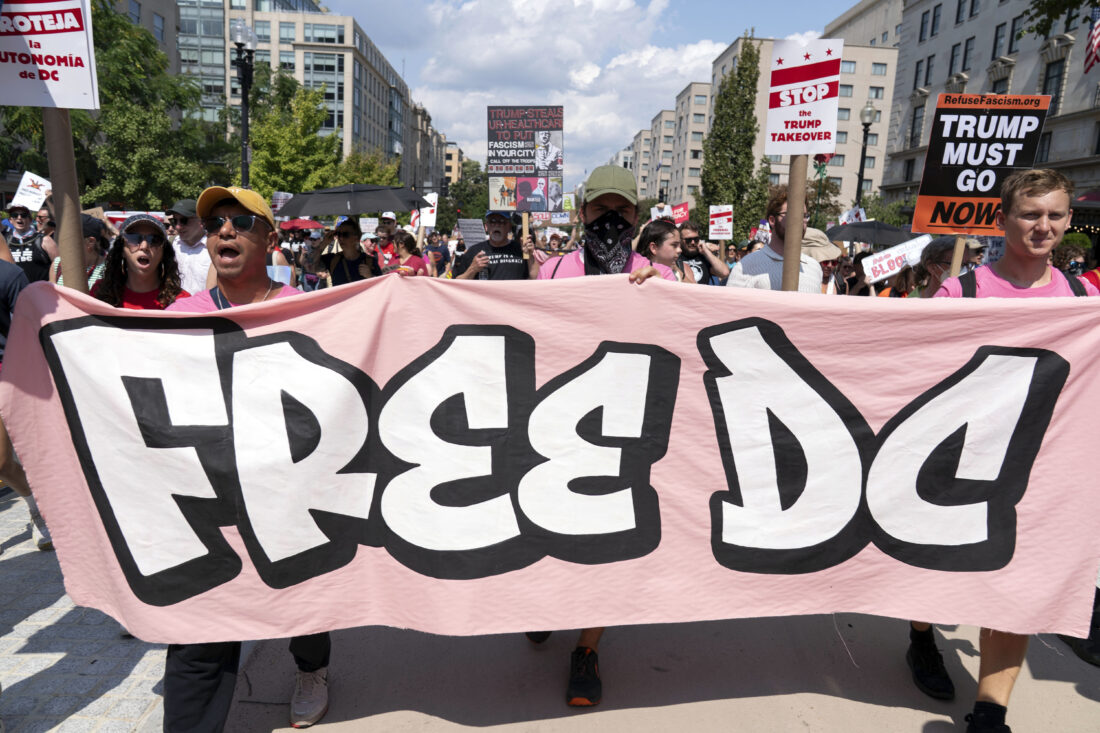Don’t go backward on how we fight violent crime. We know what works
Politicized debate threatens proven solutions in reducing homicides, violence

AP photo Demonstrators protest President Donald Trump’s deployment of federal law enforcement and National Guard troops in Washington during a march on Sept. 6.
The rhetoric over crime feels as if we’re strapped in a DeLorean and hurtling back to a dangerous future.
We’ve landed back in the late 1980s-early 1990s, an era bookended by two pieces of legislation that led to mass incarceration and huge racial disparities in sentencing: the Anti-Drug Abuse Act of 1986 and the 1994 crime bill. Fear of “superpredators” — later debunked as myth — drove policies to treat juveniles as irredeemable adult criminals. Instead of Willie Horton, now there’s Decarlos Brown Jr.
Fear, denial, and division lead us to cast blame and grasp for outdated solutions. Some voices on the left minimize legitimate concerns over urban violence. On the right, outrage over horrific crimes — such as the tragic, senseless killings of Iryna Zarutska in Charlotte and Laken Riley in Georgia — is used to justify mass arrests and deportations, harsher sentences, and threats of more National Guard deployments in cities. Meanwhile, the U.S. Justice Department has terminated hundreds of grants for violence prevention programs.
This shouldn’t be a partisan debate. After all, the aforementioned federal bills were bipartisan, and the 1994 crime bill was sponsored by Sen. Joe Biden. In his first administration, President Donald Trump signed the First Step Act, which released thousands of inmates from federal prisons and provided programs to reduce recidivism.
The recent rhetoric threatens proven anti-crime programs, argues David Kennedy, a professor of criminal justice at John Jay College, in a New York Times essay on Sept. 10, titled “What Both the Left and the Right Get Wrong About Violent Crime.”
Kennedy points to research showing that violence-intervention strategies have led to falling crime rates in Oakland, Baltimore, and other metros, but also smaller cities like Davenport. Five years ago, the Iowa city’s violent crime rate was twice the national average. With a change in police strategies, shootings are down 46% and violent crime has fallen 24%.
“The good news is that we have proven ways to reduce violent crime, and policymakers around the country are embracing them,” Kennedy writes. “The bad news is that this politicized back-and-forth is taking us away from what we know works.”
What works is recognizing that in cities big and small alike, a tiny group of people in a few neighborhoods is responsible for most of the shootings and other violence. Research in Boston, Oakland, and New Orleans, for example, shows that less than 1% of the population is part of a social network that account for more than half of the homicides, according to Thomas Abt’s 2019 book, “Bleeding Out.”
Abt argues that the first step in reducing urban poverty and improving people’s lives is to staunch the bleeding in these troubled areas. No amount of investment in education, health care, or economic development will turn around a neighborhood beset by violence. “The surest path to prosperity begins with peace,” he writes.
Abt and Kennedy lay out similar approaches: Communities must target those groups and neighborhoods with resources, balancing enforcement, prevention, and treatment. That means a strong police force that gathers intelligence on gang activity, identifies hot spots, and distinguishes between those causing the violence vs. those at risk of joining the shooting or being shot.
But it also requires an army of social workers, gang outreach specialists, ministers, coaches, business owners, grandparents, and others to reach out to “would-be shooters” and offer them alternatives and opportunities. “Like law enforcement, they must work in shifts in order to be available at all hours, they must have adequate communication and transportation that allow them to respond quickly, and they must have access to resources instantly in order to remedy a dangerous situation,” Abt writes.
Yes, it takes a village, and lots of resources.
This strategy led to youth homicides falling by almost two-thirds in Boston during the late 1990s, Kennedy writes.
What doesn’t work is indiscriminate, broad policing that sweeps up all youth in a high-crime community, instead of focusing on dangerous offenders.
“Overenforcement might lead to more arrests and more time in jail and prison, but it will not necessarily result in less violence. In fact, recklessly aggressive policing and prosecution may actually increase violence,” Abt writes, citing research on aggressive drug enforcement.
“Bleeding Out” helped inspire Safe & Thriving Youth: Central Iowa’s Youth Violence Reduction Plan, a initiative by the United Way of Central Iowa. The coalition of law enforcement, social-service providers, and civic leaders in Des Moines has launched a comprehensive strategy to reduce youth violence, support at-risk individuals, and create a safer community.
Such strategies must be led, organized, and adapted on the local level. However, federal and state funding – as well as private-sector support – is necessary to provide the resources needed.
The dividends will spread throughout a city, creating a safer, more just, fair, and prosperous community.
Or we can travel backward, falling back on fear and policies that are as effective as a flaky flux capacitor.
——-
Lynn Hicks of Des Moines is chief of staff and public information officer at the Polk County Attorney’s Office.




